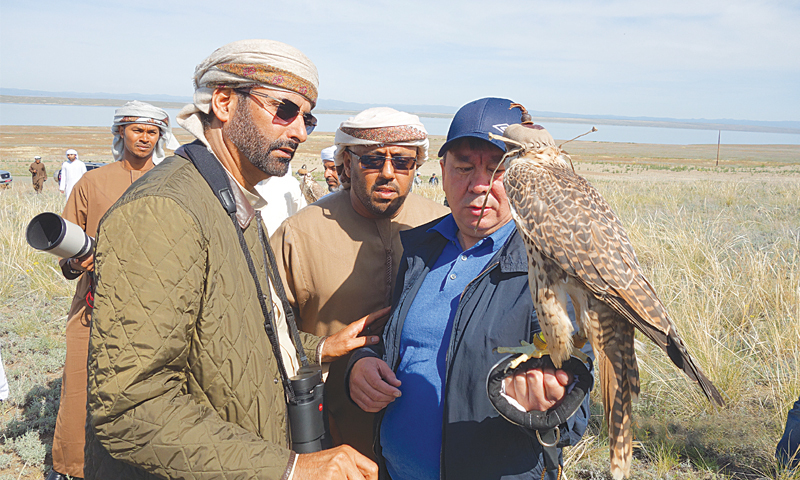Soaring high into the air, it then suddenly swoops low to snatch up its unwary prey. Its mission accomplished it returns to the writs of its master. Even from a distance, its deadly grace leaves no doubt in the watcher’s mind that he has seen a falcon at work.
Falcons are one of the fastest flying bird species and may fly at a speed of up to 250km per hour. They have exceptional powers of vision which enables them to locate their prey from almost a mile away; their thin tapered wings enable them to fly at high speeds and change direction rapidly. They are the apex predators of the skies, evolution at its finest.
For centuries, Arab falconers have captured these wild powerful birds during their autumn migration and trained them to hunt the houbara, stone curlew and hare in the winters. Traditionally, local falconers release some falcons to the wild every spring so as to not deplete the population.
Conservation is important to save the dwindling population of falcons
But despite these sporadic attempts at conservation, the falcon population began to dwindle. In 1995, the former President of the United Arab Emirates, HH (late) Sheikh Zayed bin Sultan Al Nahyan, a lover of falcons, established the Falcon Release Programme in 1995, aimed at the long-term conservation of this species.
The first release under this programme took place in Balochistan, with the release of 107 birds including 27 peregrine falcons (Falco peregrines) and 80 saker falcons (Falco cherrug). Four of the sakers were satellite-tagged in order to conduct a study on the birds’ biology and their migratory routes.
 |
Since then a total of 1,671 falcons have been returned to the wild.
This year was the 20th year of the programme and was commemorated with the greatest-ever single-year release in the programme’s history.
All falcons released this time around were tagged with microchips and identification rings at the Abu Dhabi Falcon Hospital, while four peregrine falcons and five saker falcons were also tagged with solar-powered satellite transmitters to monitor their flight paths and to gather scientific data about their survival rates.
Some 117 birds (99 Peregrine falcons and 18 Saker falcons were released by Abu Dhabi in Aktau and Oskemen, in Kazakhstan (Central Asia).
Commenting on the occasion, HE Mohammed Ahmad Al Bowardi, managing director of Environment Agency Abu Dhabi (EAD), who has led the programme since its inception, said: “It was his passion for the natural world which inspired the late Sheikh Zayed to establish Abu Dhabi’s falcon release and captive breeding programme.”
Brigadier (Retd) Mukhtar Ahmed, who also attended the ceremony said, “This is a very special anniversary and I am as delighted to be present now as I was 20 years ago to witness the release of these special birds.”
Kazakhstan is an ideal location to release falcons due to its mountains and plains, which are situated within the falcons’ migration range and due to the abundance of prey. Under the programme, birds have also been released in Pakistan, Iran and Kyrgyzstan. Release programmes in Pakistan have always been facilitated by Falcon Foundation International Pakistan.
All falcons released this time around were tagged with microchips and identification rings at the Abu Dhabi Falcon Hospital, while four peregrine falcons and five saker falcons were also tagged with solar-powered satellite transmitters to monitor their flight paths and to gather scientific data about their survival rates. Scientists use this information in subsequent releases, to provide better chances of survival to the birds.
Unesco recognised the importance of falconry in 2010 by listing it as an Intangible Cultural Heritage to Humanity. Commenting on its place in local culture, AI Bowardi said, “Traditional falconry is an essential element of our cultural heritage.
It affords us a platform of values, such as respect and patience, and a sense of continuity and belonging that is the very underpinning of our identity; providing strength in all we set out to achieve. What the programme has achieved also proves that preserving culture and promoting conservation are not contradictory, but form a partnership of mutual benefit.”
In addition to the work of Sheikh Zayed Falcon Release Programme and the Falcon Hospital, logistical, ecological and technical support for the release was provided by the International Fund for Houbara Conservation, which oversees the programme to conserve one of the falconers’ most-prized preys: the Houbara bustard. That’s Abu Dhabi’s approach to conservation, and one will have to see if it can truly take off.
Falcon Foundation International Pakistan
Published in Dawn, Sunday Magazine, September 14th, 2014












































